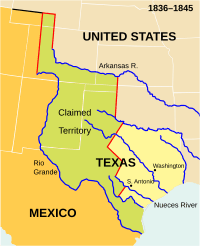Texas Declaration of Independence facts for kids
Quick facts for kids Texas Declaration of Independence |
|
| Created | March 2, 1836 |
| Location | Engrossed copy: Texas State Library and Archives Commission |
| Signers | 60 delegates to the Consultation |
| Purpose | To announce and explain separation from Mexico |
The Texas Declaration of Independence was a very important document. It officially announced that the Republic of Texas was breaking away from Mexico. This happened during the Texas Revolution. The declaration was agreed upon at a meeting called the Convention of 1836. This meeting took place in a town called Washington-on-the-Brazos on March 2, 1836. It was formally signed the next day.
Contents
Why Texas Declared Independence
In October 1835, people living in Mexican Texas started the Texas Revolution. At first, it wasn't clear what everyone wanted. Some people thought Texas should become completely independent from Mexico. Others wanted Mexico to bring back its old 1824 Constitution of Mexico. This constitution gave people more freedoms. To decide what to do, leaders called for a new meeting in March 1836.
Who Attended the Convention?
This meeting was different from earlier ones. The Mexican government had invited people from the United States to settle in Texas. They promised these settlers they would have the same freedoms they had in their home country. Most of the people at the convention wanted Texas to be independent. Forty-one delegates arrived in Washington-on-the-Brazos on February 28. Only two of the signers, Jose Francisco Ruiz and Jose Antonio Navarro, were native Texans.
Creating the Declaration
The convention started on March 1. Richard Ellis was chosen to lead the meeting. The delegates picked five people to write the declaration of independence. This group was led by George Childress. The other members were Edward Conrad, James Gaines, Bailey Hardeman, and Collin McKinney.
How Quickly Was It Written?
The committee finished writing the declaration in just 24 hours. This makes historians think that George Childress had already written most of it before the meeting even started.
What the Declaration Said
The declaration was approved on March 2 without any arguments. It was based on ideas from thinkers like John Locke and Thomas Jefferson. The declaration stated that the Mexican government "stopped protecting the lives, liberty, and property of the people." It also complained about "unfair acts of oppression and tyranny."
The declaration mentioned many reasons for Texas to separate from Mexico:
- The 1824 Constitution of Mexico, which created a federal republic, was changed. General Antonio López de Santa Anna had turned Mexico into a centralist military government.
- The Mexican government had invited settlers to Texas. It promised them freedom and a republican government. But then it broke these promises.
- Texas was joined with the Mexican state of Coahuila as Coahuila y Tejas. The capital was far away in Saltillo. This meant decisions for Texas were made very far away. Also, they were made in Spanish language, which many settlers did not understand.
- Settlers were denied important rights they had in the United States. These included the right to keep and bear arms and the right to a trial by jury.
- There was no system for public education.
- The Mexican government tried to collect taxes on imported goods. The declaration called these "pirate attacks."
- Settlers were not allowed freedom of religion. All legal settlers had to become Catholic.
Key Ideas from the Declaration
The Texas Declaration also included many famous ideas about freedom and government. These were similar to the United States Declaration of Independence. For example, it talked about:
- "The right of trial by jury, that protection of civil liberty, and only safe guarantee for the life, liberty, and property of the citizen."
- "Our arms... are essential to our defense, the rightful property of freemen, and formidable only to tyrannical governments."
The declaration officially created the Republic of Texas. However, no other government recognized it as a country at that time. Mexico still claimed the land and saw the delegates as invaders.
Who Signed the Declaration?
Sixty men signed the Texas Declaration of Independence. Most of them, fifty-seven, had moved to Texas from the United States. Three were born in Mexico. Fifty-nine of the signers were delegates to the convention. One, Herbert S. Kimble, was the Convention Secretary.
- Jesse B. Badgett
- George Washington Barnett
- Thomas Barnett
- Stephen W. Blount
- John W. Bower
- Asa Brigham
- Andrew Briscoe
- John Wheeler Bunton
- John S. D. Byrom
- Mathew Caldwell
- Samuel Price Carson
- George C. Childress
- William Clark, Jr.
- Robert M. Coleman
- James Collinsworth
- Edward Conrad
- William Carroll Crawford
- Lorenzo de Zavala
- Richard Ellis, President of the Convention and Delegate from Red River
- Stephen H. Everett
- John Fisher
- Samuel Rhoads Fisher
- Robert Thomas 'James' Gaines
- Thomas J. Gazley
- Benjamin Briggs Goodrich
- Jesse Grimes
- Robert Hamilton
- Bailey Hardeman
- Augustine B. Hardin
- Sam Houston
- Herbert Simms Kimble, Secretary
- William D. Lacy
- Albert Hamilton Latimer
- Edwin O. Legrand
- Collin McKinney
- Samuel A. Maverick (from Bejar)
- Michel B. Menard
- William Menefee
- John W. Moore
- William Motley
- José Antonio Navarro
- Martin Parmer, Delegate from San Augustine
- Sydney O. Pennington
- Robert Potter
- James Power
- John S. Roberts
- Sterling C. Robertson
- José Francisco Ruiz
- Thomas Jefferson Rusk
- William. B. Scates
- George W. Smyth
- Elijah Stapp, ancestor of Brown family
- Charles B. Stewart
- James G. Swisher
- Charles S. Taylor
- David Thomas
- John Turner
- Edwin Waller
- Claiborne West
- James B. Woods



